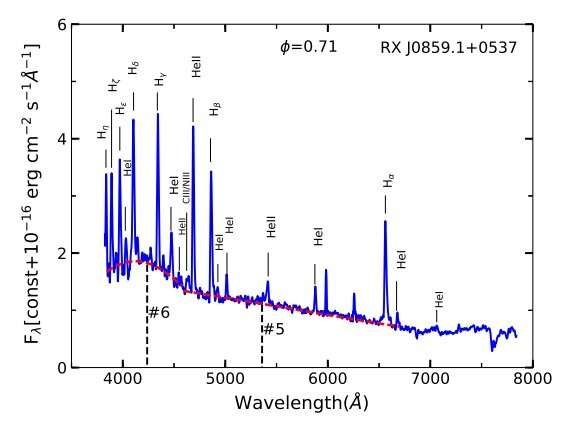Optical spectrum of RX J0859.1+0537. Credit: Joshi et al., 2019.
Cataclysmic variables (CVs) are binary star systems consisting of a white dwarf and a normal star companion. They irregularly increase in brightness by a large factor, then drop back down to a quiescent state. Although over 140 polars have been detected to date, only 33 of them have been identified as eclipsing systems. Observations of these rare objects could offer astronomers more opportunities to study magnetic accretion in binaries, for instance.
Indian astronomers have conducted an optical and x-ray study of three polars, a subclass of cataclysmic variables distinguished from other CVs by the presence of a very strong magnetic field in their white dwarfs. Specifically, they studied RX J0859.1+0537, RX J0749.1-0549 and RX J0649.8-0737. Results of the new study, presented in a paper published November 4 on arXiv.org, provide more details regarding fundamental properties of the three polars, which could advance the knowledge about such objects in general.
RX J0859.1+0537 (or RX J0859 for short), RX J0749.1-0549 (RX J0749), and RX J0649.8-0737 (RX J0649) are poorly studied polars located some 1,437 light years, 3,807 light years and 1,991 light years away from the Earth, respectively. In order to get more insights into the nature of the three polars, a team of astronomers led by Arti Joshi of Aryabhatta Research Institute of Observational Sciences in India performed optical photometric and spectroscopic observations of these objects. The study was complemented by an analysis of archival X-ray data.
"The poor knowledge of these sources encouraged us to do the optical (photometric and spectroscopic) and X-ray study," the astronomers wrote in the paper.
In general, the study confirmed that RX J0859, RX J0749 and RX J0649 belong to a class of eclipsing polars. The light curves of these sources showcase eclipse features that are deep, total and variable in shape. The optical spectra of all the three systems exhibit strong, high-ionization emission lines and an inverted Balmer decrement, which confirms their magnetic nature.
According to the research, RX J0859, RX J0749 and RX J0649 have orbital periods of 2.39, 3.67 and 4.35 hours, respectively. Taking into account these results, the researchers classified RX J0859 as an eclipsing polar lying in the region of the period gap, while the other two were found to be long-period eclipsing polars above the period gap.
The astronomers found that for all the three systems, the radius of the eclipsed light source is found to be more than the actual size of the white dwarf. This suggest that the eclipsed component is not only a white dwarf, but may also be an extended accretion stream or an extended magnetic region on the white dwarf surface.
Moreover, the researchers identified cyclotron humps in the optical spectra of the three polars. This allowed them to measure the magnetic field strength of the surface of white dwarfs in these systems. This value was calculated to be at a level of about 49, 43.5, and 44 MG for RX J0859, RX J0749, and RX J0649, respectively.
More information: Optical and X-ray studies of three polars: RX J0859.1+0537, RX J0749.1-0549, and RX J0649.8-0737, arXiv:1910.11058 [astro-ph.SR] arxiv.org/abs/1910.11058
© 2019 Science X Network
























